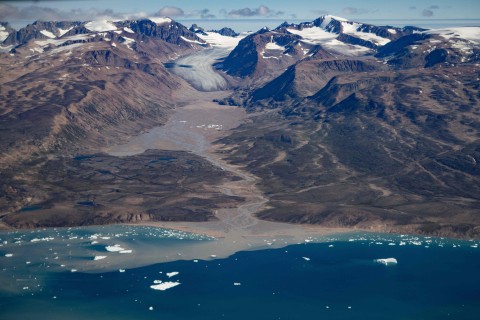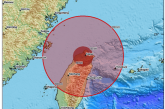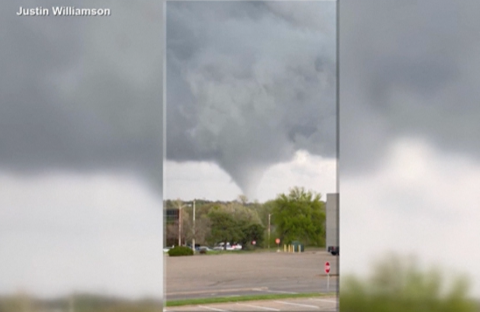Pinakamainit na Arctic summer, dulot ng bumibilis na pagbabago sa klima

(FILES) This aerial photograph taken on August 11, 2023 shows a glacier around “Constable Point” severely melted due to warm temperatures along the Scoresby Sound Fjord, in Eastern Greenland. The Arctic saw its warmest ever summer in 2023, the result of accelerating human-caused climate change that is pushing ecosystems and the people that depend on them into uncharted territory, according to an official report on December 12, 2023. Average summer surface air temperature from the months of July-September was 43 degrees Fahrenheit (6.4 Celsius), the highest since records began in 1900. (Photo by Olivier MORIN / AFP)
Dumanas ang Arctic ng pinakamainit nitong summer ngayong 2023, na resulta ng bumibilis na climate change o pagbabago ng klima na gawa ng tao, na nagtulak naman sa ecosystem at mga taong umaasa rito sa hindi matukoy na teritoryo.
Ang average na temperatura ng summer surface air tempereature mula sa mga buwan ng Hulyo-Setyembre ay 43 degrees Fahrenheit (6.4 Celsius), ang pinakamataas mula nang simulan ang pagtatala noong 1900.
Ang Arctic ay umiinit nang humigit-kumulang apat na beses na mas mabilis kaysa sa iba pang bahagi ng planeta, pangunahin bilang resulta ng isang matinding cycle ng pagkatunaw ng yelo sa dagat sa isang phenomenon na tinatawag na Arctic Amplification.
Sinabi ni National Oceanic and Atmospheric Administration (NOAA) administrator Rick Spinrad, “The overriding message from this year’s report card is that the time for action is now. We as a nation and global community must dramatically reduce greenhouse gas emissions that are driving these changes.”
Ang average summer temperatures ay tumataas ng 0.31 F (0.17 C) bawat dekada.
Sa pangkalahatan, ito ang ika-anim na pinakamainit na summer sa Arctic, 20 degrees Fahrenheit (-7 C).
Ngayon na nasa kanila nang ika-18 taon, ang NOAA Arctic Report Card ay resulta ng magkatuwang na trabaho ng 82 authors ng 13 mga bansa.
Ang mga obserbasyon mula sa ulat sa taong ito ay nagbibigay-diin sa isang ongoing trend line ng pag-init ng temperatura ng dagat at hangin, nababawasang snow cover, pagkawala ng yelo sa dagat, at patuloy na pagkatunaw ng Greenland Ice Sheet.
Subalit ang taon na ito ay nagdala rin ng high impact events na mayroong “clear signature” ng climate change.
Sinabi ng co-author na si Tom Ballinger ng University of Alaska Fairbanks, “While the Arctic is growing wetter, there are distinct regional and seasonal differences. For example, a wet winter characterized portions of Alaska, though a dry spring was observed over western Eurasia and northern Canada was impacted by a dry summer.”
Ang mainit at tuyong mga kondisyon ng tag-araw sa hilagang Canada, na sinabayan ng maagang pagkatunaw ng yelo ay nag-ambag upang maranasan sa Canadian Arctic ang pinakamalala nitong wildfire season na naitala, na naging sanhi ng paglikas ng 20,000 katao mula sa bayan ng Yellowknife noong Agosto.
Noong Agosto rin, isang glacial lake malapit sa Juneau, Alaska ang sumabog sa dam, na nagdulot ng matinding pagbaha at pagkasira ng mga ari-arian sa kahabaan ng Mendenhall River, bilang resulta ng dalawang dekada nang glacial thinning.
Ang long term warming trend ay may magkakaiba at hindi pare-parehong epekto sa buong ecosystems at food webs na inaasahan ng mga tao.
Halimbawa nito, sinabi ng co-author na si Daniel Schindler ng University of Washington, “Sockeye salmon reached a record-high abundance in Bristol Bay, Alaska in the years 2021 and 2022. The species, a staple of commercial fisheries, has thrived under warmer waters. Increased plankton abundance has allowed juveniles to grow faster in lakes and increase their odds of survival when they reach the ocean.”
Aniya, “But record high catches have flooded markets and depressed wholesale prices to their lowest levels in decades,”
Sa kabilang banda, ang chinook at chum salmon na inaasahan ng Indigenous communities ay lubha namang nabawasan kasunod ng matinding heat waves na nagkaroon ng negatibong epekto sa kanilang growth rates, na sanhi upang ang adult chinook at chum salmon ay maging mas maliit, sa hindi maintindihang kadahilanan.
Ayon pa kay Schindler, “Livelihoods, nutrition and cultures at the subsistence communities have all been heavily impacted.”
Sa isa pang chapter ng report, ay sinuri naman ang subsea permafrost, isang larangan na hindi gaanong kilala, kahit na sa kalipunan ng mga scientist, bagama’t isa itong mahalagang pinagmumulan ng greenhouse gas emissions.
Nang malampasan ng mundo ang huling ice age, ang pagtaas ng tubig sa Arctic ay tumabon sa permafrost, at ginawa iyong subsea permafrost sa loob ng libu-libong taon.
Nakasaad sa report, “An estimated 2.5 million km2 of subsea permafrost remains today, but it continues to thaw due to the original ocean inundation event and more recent, rapid Arctic warming.”




